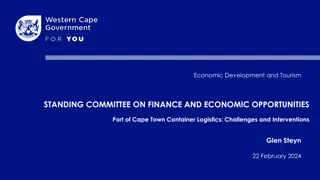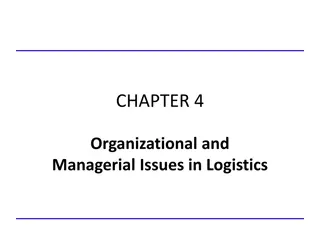
CSE 421: Winter 23 Lecture Notes and Logistics
Delve into the early notes and logistics for CSE 421 Winter '23, featuring topics such as stable matchings, staff details, to-dos, syllabus information, recommended textbooks, and lecture activities. Get ready for an engaging learning experience with active participation encouraged for optimal understanding and engagement.
Download Presentation

Please find below an Image/Link to download the presentation.
The content on the website is provided AS IS for your information and personal use only. It may not be sold, licensed, or shared on other websites without obtaining consent from the author. If you encounter any issues during the download, it is possible that the publisher has removed the file from their server.
You are allowed to download the files provided on this website for personal or commercial use, subject to the condition that they are used lawfully. All files are the property of their respective owners.
The content on the website is provided AS IS for your information and personal use only. It may not be sold, licensed, or shared on other websites without obtaining consent from the author.
E N D
Presentation Transcript
Here Early? Here for CSE 421? Welcome! You re early! Want a copy of these slides to take notes? You can download them from the webpage cs.uw.edu/421
Stable Matchings CSE 421 Winter 23 Lecture 1
Today Logistics What is this course? Start of the content
Staff TAs Abhinav Bandari Daniel Cheng Airei Fukuzawa Anna Goncharenko Kasper Lindberg Allie Pfleger Alicia Stepin Jack Zhang Muru Zhang Instructor: Robbie Weber Ph.D. from UW CSE in theory Third year as teaching faculty Office: CSE2 311 Email: rtweber2@cs.washington.edu
TODO List Make sure you re on Ed! (check your spam folder for an invite, if not there send an email to Robbie). Go to section tomorrow. Homework 1 is will be out tonight (should be able to start after section).
Syllabus It s all on the webpage: https://courses.cs.washington.edu/courses/cse421/23wi/ In general, we re designing lecture to be synchronous (taking questions live, time for student discussions). But we re trying to make sure if you need to stay home for a few days on short notice the effect will be minimal.
Textbook Optional: Optional: Algorithm Design by Kleinberg & Tardos It s a good introduction, and nice as a reference. There are lots of other books: Introduction to algorithms by Cormen, Leiserson, Rivest, Stein One free reference: Algorithms by Jeff Erickson Algorithms.wtf
Logistics Lecture Activities I m going to be teaching with active learning Why? Because it works. https://www.pnas.org/content/111/23/8410 a meta-analysis of 225 studies. Just listening to me isn t as good for you as listening to me then trying problems on your own and with each other. The answers live help me adjust explanations. active learning in this course. There aren t points associated with completing the activities.
Logistics where to go? Slides, homework problems, etc. go up on the webpage Homework submission on gradescope Live lecture activities on polleverywhere Questions on Ed discussion board Don t trust canvas we won t be updating frequently. We ll tell you when we re using it for specific purposes.
Late Policy A little different from what you re used to! We re counting late problems problems instead of late days You can use a late problem to turn in a problem up to 48 hours late. That applies to one problem not the other 3 on the assignment But you can use more than one per assignment You have 6 to use. days. We ll also drop a few of your lowest scores. Details on the syllabus.
Logistics Work 8 (approximately) weekly homework assignments A midterm exam In the evening evening of Monday February 13th. We ll have alternate exams for people with immovable conflicts, but please put that date on your calendar now! A final exam (as on the official schedule, Monday March 13, 2:30 PM)
Hey, Were in a pandemic The staff is going to do our best to help you learn. Real life is going to get in the way. If it does, tell us as soon as possible, and we ll work with you. I don t need to know private details, just enough to know it s an emergency and how to help. We will endeavor not to make any substantial changes to the syllabus. But if something extremely unexpected happens we reserve the right to make changes. Generally prefer individual accommodations, rather than course-wide ones.
What is this course? Algorithms themes: Design Techniques not just here s an algorithm but here s a way of thinking about a class of algorithms Modeling In the real world, no one will say I need you to run Prim s algorithm on this graph they will say I need you to choose where to build electrical wires so every town is connected to the power plant as cheaply as possible Set realistic expectations there are some things we (think/know) computers can t do efficiently. How do you recognize these problems? Reductions if you ve already solved a problem, don t solve it again (reuse ideas) and if you know you can t solve a problem, what else can t you solve.
What is this course not NOT: A list of the fastest-known algorithms for common problems. I m not concerned with which library is best. The best library changes over time and by language. I m not qualified to keep a list. I want you to find this course useful 5 years from now. And the best theoretical algorithms probably aren t practical and when they are, it s often clever combinations/complicated variants of big ideas that we ll see.
Course Topics (Tentative) Stable Matchings Graph Algorithms/Modeling (BFS/DFS and some new algorithms) Greedy Algorithms Divide & Conquer Dynamic Programming Network Flow Linear Programming P/NP
Whats Coming Up This week: An extremely useful algorithm. That has had lots of effect on the real world. Along the way: Examples of what we mean by an algorithm description We won t use Java How do we prove algorithms correct? Resetting expectations on proofs.
Stable Matchings Motivation: You have to assign TAs to instructors. Two groups of people you need to pair off, with preferences about their matches. You can t make everyone happy so at least ensure that everyone listens to you. There are lots of other similar applications Assign doctors to the hospitals where they do residency. Assign high schoolers to magnet schools. Among many, many other applications.
Motivation The real world is complicated. Students shouldn t TA a course they haven t taken. Instructors need varying numbers of TAs. There are more TA applicants than positions. Doctors might want to be in the same city as their partner. We re going to simplify away the real world constraints. The core ideas have been adapted to all of these scenarios.
Stable Matching Problem To simplify. We have two sets: A set of ? horses, and a set of ? riders. Every rider can ride any horse, and vice versa. We just need to pair them off. What could go wrong?
Stable Matching Problem Given two sets R = ?1, ,??,? = { 1, , ?} each agent ranks every every agent in the other set. Goal: Match each agent to exactly one their preferences. How do we respect preferences ? Avoid blocking pairs: unmatched pairs (?, ) where ? prefers to their match, and prefers ? to its match. ? , exactly one agent in the other set, respecting ?,? ?
Stable Matching, More Formally Perfect matching: Each rider is paired with exactly one horse. Each horse is paired with exactly one rider. Stability: no ability to exchange an unmatched pair ?- is blocking if they both prefer each other to current matches. Stable matching: perfect matching with no blocking pairs. Stable Matching Problem Given: the preference lists of ? riders and ? horses. Find: a stable matching.
Lecture Activity To make sure you ve got the definition: 1. Download the activity pdf from the webpage (it s just the next slide in this slide deck) or look at the physical handout. 2. Introduce yourself to those around you. 3. Try the problem. 4. Fill out the polleverywhere
Try it! Why are these not stable matchings? ?1 1 ?1 ,?2 ?1 1 , 2 1 ?1 ,?2 1 , 2 ?2 2 ?1 ,?2 1 , 2 ?2 2 ?1 ,?2 1 , 2 Find a stable matching for this instance. ?1 ?1 ,?2,?3 1 1 , 2, 3 ?2 2 2 , 1, 3 ?1 ,?2,?3 pollev.com/robbie 1 , 2, 3 ?3 3 ?1 ,?2,?3
Questions Does a stable matching always exist? Can we find a stable matching efficiently? We ll answer both of those questions in the next few lectures. Let s start with the second one.
Idea for an Algorithm Key idea Unmatched riders propose to the highest horse on their preference list that they have not already proposed to. Send in a rider to walk up to their favorite horse. Everyone in front of a different horse? Done! If more than one rider is at the same horse, let the horse decide its favorite. Rejected riders go back outside. Repeat until you have a perfect matching.
Gale-Shapley Algorithm Initially all ? in ? and in ? are free while there is a free ? Let be highest on ?s list that ? has not proposed to if is free match (?, ) else // is not free Let ? be the current match of . if prefers ? to r unmatch (? , ) match (?, )
Algorithm Example ?1 1 ?2 ,?3,?1 1 , 2, 3 ?2 2 1 , 3, 2 ?3 ,?1,?2 3 1 , 2, 3 ?3 ?3 ,?1,?2 Proposals: ?1,?2,?1,?3,?3,?1
Does this algorithm work? Does it run in a reasonable amount of time? Is the result correct (i.e. a stable matching)? Begin by identifying invariants and measures of progress Observation A: r s proposals get worse for them. Observation B: Once h is matched, h stays matched. Observation C: h s partners get better. How do we justify these? A one-sentence explanation would suffice for each of these on the homework. How did we know these were the right observations? Practice. And editing we wouldn t have found these the first time, but after reading through early proof attempts.
Does this algorithm work? Want to show two things: 1. The code produces the right output (i.e., you get a stable matching) 2. The code runs in a reasonable amount of time. We ll start with question 2.
Claim 1: If ? proposed to the last horse on their list, then all the horses are matched.
Claim 1: If ? proposed to the last horse on their list, then all the horses are matched. Try to prove this claim, i.e. clearly explain why it is true. You might want some of these observations: Observation A: ? s proposals get worse (for ?). Observation B: Once is matched, never becomes free again. Observation C: s partners cannot get worse (for ). Hint: ? must have been rejected a lot what does that mean?
Claim 1: If ? proposed to the last horse on their list, then all the horses are matched. Hint: ? must have been rejected a lot what does that mean? Since we immediately match any horse we un-match in the algorithm, once a horse receives any proposal it is not free for the rest of the algorithm. (Observation B). Since ? proposes to horses on its list in order, every horse on ? s list must be matched. And every horse is on ? s list! So once a rider proposes to the last horse on their list, all horses are matched.
Claim 2: The algorithm stops after ? ?2 iterations. Hint: When do we exit the loop? (Use claim 1). If every horse is matched, every rider must be matched too. -Because each horse is matched to exactly one rider and there are an equal number of riders and horses. Since we don t repeat a proposal, and each of the ? riders have lists of length ?, It takes at most ? ?2 proposals to get to the end of some rider s list. Claim 2 now follows from Claim 1. That s the number of iterations. What about time per iteration?
Wrapping up the running time We need ?(?2) proposals. But how many steps does the full algorithm execute? Depends on how we implement it we re going to need some data structures. With the right data structures the running time really is ?(?2). More details in the optional slides at the end of this deck.
TODO List Make sure you re on Ed! (check your spam folder for an invite, if not there send an email to Robbie). Go to section tomorrow Start on HW1
Optional Content Data Structure Tricks to run Gale-Shapley in ?(?2) time.
Gale-Shapley Algorithm Initially all ? in ? and in ? are free while there is a free ? Let be highest on ? s list that ? has not proposed to if is free match (?, ) else // is not free Let ? be the current match of . if prefers ? to r unmatch (? , ) match (?, ) Are each of these operations really ?(1)? Assume that you get two int[][] with the preferences.
Wrapping up the running time We need ?(?2) proposals. But how many steps does the full algorithm execute? Depends on how we implement it we re going to need some data structures.
Gale-Shapley Algorithm Initially all ? in ? and in ? are free while there is a free ? Let be highest on ? s list that ? has not proposed to if is free match (?, ) else // is not free Let ? be the current match of . if prefers ? to r unmatch (? , ) match (?, ) Are each of these operations really ?(1)? Assume that you get two int[][] with the preferences.
Gale-Shapley Algorithm Initially all ? in ? and in ? are free while there is a free ? Let be highest on ? s list that ? has not proposed to if is free match (?, ) else // is not free Let ? be the current match of . if prefers ? to r unmatch (? , ) match (?, ) Need to maintain free ?. What can insert and remove in ? 1 time? Each ? should know where it is on its list. Maintain partial matching Given two riders, which horse is preferred? Maintain partial matching Are each of these operations really ?(1)? Assume that you get two int[][] with the preferences. Horse[i][j] gives the identity of the ?th rider on horse ? s list.
What data structures? Need to maintain free ?. What can insert and remove in ? 1 time? Queue, stack, or list (inserting at end) all would be fine. Maintain partial matching Two arrays (index i has number for partner of agent i. Each ? should know where it is on its list. int for each rider (likely store in an array) Given two riders, which is preferred? Lookup in int[][]takes ?(?) in the worst case. Uh-oh. Better idea: build inverse arrays (given rider, what is their rank One time cost of?(?2) time and space to build, but comparisons ?(1). rank for horse?).
What data structures? These aren t the only options you might decide on an object- based approach (can meet same time bounds up to constant factors) Need to maintain free ?. What can insert and remove in ? 1 time? Queue, stack, or list (inserting at end) all would be fine. Maintain partial matching How do we handle the lookup? Two arrays (index i has number for partner of agent i). Each ? should know where it is on its list. int for each rider (likely store in an array) Given two riders, which is preferred? Lookup in int[][]takes ?(?) in the worst case. Uh-oh. Better idea: build inverse arrays (given rider, what is their rank One time cost of?(?2) time and space to build, but comparisons ?(1). rank for horse?).
Changing The Question Horse[i][j] asks horse ? who their ?th favorite rider is. To ask Horse ?, do you prefer rider 3 or rider 5 we d have to iterate through Horse[i][k] as ? goes from 0 to ? 1, until we see 3 or 5. It would be better if we could ask horse ?, where is rider 3on your list? and horse ?, where is rider 5on your list? have it say 2ndon my list and 8thon my list to let us say well 2 < 8, so you would prefer rider 3. Let s make a data structure to answer the other question.
Inverse Array Inv[i][j]answers the question Hey, horse ?, what position in your list is rider ?? for(int k=0; k<n; k++){ int riderNum = horse[i][k]; Inv[i][riderNum]=k; } riderNum is the identity of the rider who is in position ?. So when we ask about riderNum, the answer should be ?.
Inverse Array Repeat that code for every ? (probably making a 2-D inverse array), and you ll have ?(1)access to answer the question Rider 7, Do you prefer horse 3 or horse 5? How long does it take to create? ?(?2) time total. So as a pre-computation step, create the inverse arrays. Then run Gale- Shapley as shown a few slides ago. Every other step was ?(1)time, so So the final running time of Gale-Shapley will be ?(?2)






















